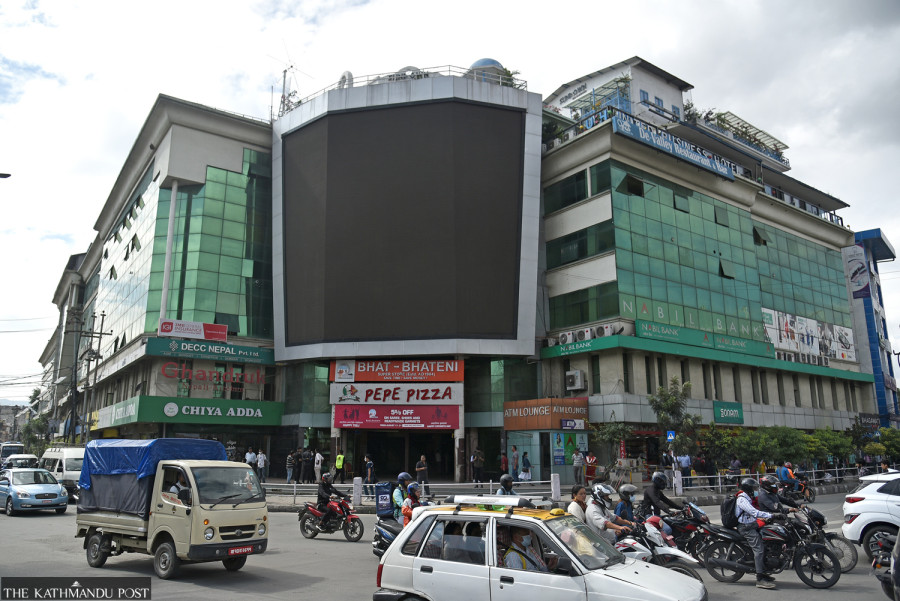Kathmandu
Kathmandu Metropolitan City removes unauthorised digital hoarding boards
Urban planners and heritage activists welcome the move, saying visual pollutants must be cleared to keep the city clean.
Anup Ojha
As the Kathmandu Metropolitan City has continued its drive to clear illegal structures in public spaces, it has also launched a campaign to remove all the illegal hoarding boards in the city.
On Thursday, the KMC shut down the digital advertising board at the World Trade Centre, Tripureshwar.
“We have asked those concerned to remove the digital hoarding board as it was kept without taking permission from the city authorities,” said Nabin Manandhar, spokesperson at the KMC.
He said the KMC is also going to clear other such hoarding boards from Durbar Marg and other areas.
“We are strictly monitoring such boards. They are visual pollutants and also many have not not taken permission,” said Manandhar.
Ever since the giant digital hoarding board was placed at the World Trade Centre in Tripureshwar, commuters as well as traffic police had complained to the KMC, saying it was a distraction and could cause accidents.
Raju Nath Pandey, the newly-appointed chief of city police who had reached Tripureshwar on Thursday after Mayor Balendra Shah ordered him to clear the digital board, said KMC allows only 800 square feet of such digital boards, and the one at the World Trade Centre covered 1,600 square feet.
“It even blocked the windows. Earlier also the KMC had asked to remove it numerous times,” said Pandey.
The Advertising Board Promotional Material Regulation Policy 2013 of the KMC states that it is illegal to install commercial hoarding boards and advertising materials on additional frames on rooftops, and balconies of private and public houses.
In 2019, the KMC had announced plans to clear all hoarding boards from the streets, only allowing digital ones, but there was no monitoring.
Now, the KMC is going to remove all such displays, both billboards and digital hoarding boards, from the city area, Shiva Raj Adhikari, chief of the KMC’s Revenue Department, told the Post.
“We are in a bid to make the city clean, free of hoarding boards,” Adhikari said.
Lately, under Mayor Shah, the KMC has been praised for some of its drives, such as the demolition of illegally-built structures and crackdown on misuse of parking spaces, after facing criticism for failing to manage the city’s waste.
On Wednesday, the KMC’s Revenue Department sent a letter to the Bhrikutimandap-based Kathmandu Funpark asking it to clear all due taxes within 24 hours.
The amusement park paid all due taxes on Thursday, according to Manandhar, the KMC spokesperson. “The Funpark has cleared all taxes it had to pay to the City,” Manandhar told the Post. As per the information given by the Revenue department, the Funpark has paid Rs1.7 million as entertainment tax to the city.
Heritage activists and urban planners had been complaining for long about the haphazardly installed hoarding boards and digital advertising screens.
Kishore Thapa, an urban planner and former government secretary, said the drive to remove such digital and hoarding boards is a good initiative.
“Such advertising boards not only cause visual pollution but also raise the risk of accidents,” Thapa said.
According to him, such boards should be installed only after studying if they could cause accidents or not.
“For example, if the city lets such boards operate within business complexes, that should be fine,” he said.
Similarly, Ganapati Lal Shrestha, a heritage activist, says the KMC’s action is a welcome move.
“Kathmandu is a heritage city and those hoarding boards were kept only for commercial purposes, and they created visual disturbances to the public,” said Shrestha.
He, however, requested the KMC not to repeat past mistakes.
“Earlier also it removed such boards and warned of not renewing the contracts, but later it allowed such boards in exchange for kickbacks,” he said.
Visual pollution has been an issue in Kathmandu for quite some time.
Unhappy with the presence of visual pollutants around the city, senior advocate Padma Bahadur Shrestha had filed a writ petition in 2014 demanding removal of all such hoarding boards and digital screens from public places.
Responding to the petition, the Supreme Court had first issued an interim order to the local authorities and the government to maintain a clean environment in the city.
The final verdict, issued on September 2, 2015, ordered the authorities concerned to maintain the civilised appearance of the city and remove the visual pollutants from core city areas. The court’s verdict, however, went unimplemented for a long time.




 16.12°C Kathmandu
16.12°C Kathmandu.jpg)











